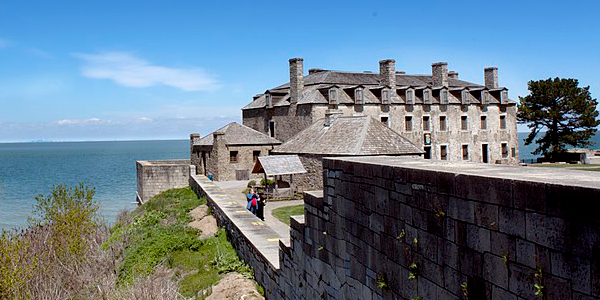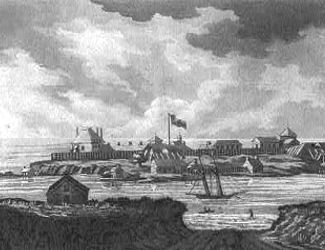
Image above: Battery, bakery, and French Castle at Fort Niagara, date unknown, Historic American Buildings Survey. Courtesy Library of Congress.
Spotlight on Lesser Known History
Fort Niagara, New York
America's Best History Spotlight
On this page we're going to Spotlight the lesser known historic sites and attractions that dot the history landscape across the USA and are worth a visit if you're in their area. And while they may be lesser known, some are very unique, and will be that rare find. You'll be, at times, on the ground floor, or maybe even know something others don't. It'll be fun. Visit them.

Fort Niagara, New York
The French had been battling the British for supremacy in the fur trade, plus settlement in the northeast, in wars for who would control the area along what is today's Canada border. In 1720, they would build Fort Niagara on the southern shore of Lake Ontario, not knowing when it might see battle, but it would. Thirty-nine years later, the French and Indian War would come to its doorstep, and end with the British in control. That wasn't what they had been thinking upon its construction, or use. But, that's what history brought. Today, you can visit this awesome site, now a New York State Historic site, and walk the ramparts, tour the French Castle, and even see distant views of Toronto across the lake. You'll be transported back in time, a time of the fur trade, war with the British, and more. Image above: Old Fort Niagara, 1900, Detroit Photographic Company. Courtesy Library of Congress.
Sponsor this page for $100 per year. Your banner or text ad can fill the space above.
Click here to Sponsor the page and how to reserve your ad.
Info, What's There Now, History Nearby

Fort Niagara, New York
Fort Niagara was built to keep the British at bay. Now, it welcomes the British, American, Canadian, and other public, over 750,000 tourists per year, to witness the walls that tell stories which began all the way back in the 1720's. So that history is three hundred years old, with the importance of the strategic site along the Niagara River and Lake Ontario understood by Native Americans, French traders, and New France.
They even understood the location's importance prior to construction, and completion, of Fort Niagara in 1726. In 1678, Fort Conti had been built by French explorers under the command of Rene'-Robert Cavelier, Sieur de La Salle; it was replaced by Fort Denonville, built under orders of the Marquis de Denonville, Governor of New France, on the same site in 1687. He posted one hundred soldiers there that winter; only twelve survived, so they tore the fort down the next September.
Image above: Fort Niagara looking over Lake Ontario, 2007, Adithyavr. Courtesy Wikipedia Commons. Below: Wife of a Soldier, 1860, T.Walker, published by Virtue, Emmins, and Company. Courtesy Library of Congress.

Where Is It
Fort Niagara is located at 102 Morrow Plaza, Youngstown, New York, 14174. The fort is off I-190 Exit 25B. That's just under seven hours from New York City; nearly five hours from Albany; three hours from Syracuse; forty minutes from Buffalo; and fourteen miles and twenty-four minutes from Niagara Falls proper. In the area of Niagara Falls from May to October, you can hop on the Discover Niagara Shuttle and be transported to Fort Niagara and other sites. For many, that's a good way to get there. And it's free.
What is There Now
There's so much here, including a sixteeen minute orientation film, the French Castle, living history, gift shop, spectacular views of Lake Ontario, original buildings from the fur trade and Indian history, redoubts, cannons, and more. There's also the Log Cabin Eatery where you can get some food. Old Fort Niagara is part of Fort Niagara State Park, which includes five hundred acres and the historic 1872 Lighthouse and other history points of interest.
When Open and How Much
A day pass is $15.00 for adults and $10.00 for children 6-12. Five and under are free. The fort is open year round, closed on major holidays, and may be closed certain days of the week. Call ahead for the current schedule. The Discover Niagara Shuttle is free.
Fees subject to change.
Websites
Old Fort Niagara
Fort Niagara State Park
Discover Niagara Shuttle
History Nearby
Well, it's understood that if you're in this area of New York, you're likely visiting the pleasures of Niagara Falls. On your way from the larger cities south, there's much to visit as well; think Theodore Roosevelt Inaugural National Historic Site in Buffalo, the national sites of Women's Rights and Harriet Tubman, Saratoga, Cooperstown, the unique Mohonk Mountain House, plus Fort Ticonderoga, if you're fort centric, and the Erie Canalway Heritage Corridor, if you're canal centric.
Buy Chronology

Great Book for the History Fan with Fifty Short Essays Telling the Story of American History.
Photos, History, and More Spotlights

Construction of the Fort
In May 1720, the Senecas agreed to allow Louis-Thomas, Chabert de Joncaire and ten men from Fort Frontenac to build a trading post for furs on the right bank of the Niagara River known as Le Magazin Royale, the Royal Store or House of Peace. This was the modest beginning of Fort Niagara. By 1726, the French Castle was built above the shoreline by a French engineer known as Gaspard-Joseph Chaussegros de Le'ry.
As tensions mounted between the British in New England and the French to their north and west, the fort expanded to its present size by 1755, much under the supervision of French Army Captain Pierre Pouchot.
Photo above: Drawing depicting the 1728 era of Fort Niagara, 2009, Charny. Courtesy Wikipedia Commons.

French and Indian War
From July 6 to 26, 1759, the British lay siege to Fort Niagara, wishing to remove the French from control of the Great Lakes and the Ohio Valley. The French had garrisoned three thousand there, an additional two thousand five hundred added to the normal strength of the fort under Pouchot. But Pouchot made a mistake in June, sending reinforcements to other forts in the region and leaving him with only five hundred and twenty men. When the British approached with nearly four thousand soldiers and Iroquois warriors under the commands of John Prideaux, William Johnson, and Seneca chief Sayenqueraghta, the French were greatly outnumbered.
When a relief force from New France was defeated at the Battle of La Belle-Famille, there was little choice for Pouchot but to surrender on July 26. The Siege of Fort Niagara was over on the same day the French lost Fort Carillon (Fort Ticonderoga). The fort would be British held for the next thirty-seven years.
Photo above: French Castle at Fort Niagara, 2017, Adithyvr. Courtesy Wikipedia Commons.

Fort Niagara After the French and Indian War
During the American Revolution, Fort Niagara was a Loyalist base for the British, coming under control of the new nation of the United States after the Treaty of Paris in 1783. Even though technically USA territory, it was still under effective British control until the Jay Treaty in 1795. American troops began to occupy the fort the next year.
During the War of 1812, the British captured the fort on December 19, 1813, retaliating for the attack on the village in southern Ontario of today's Niagara-on-the-Lake, then known as Newark (founded 1792), nine days earlier. They would control the fort for the remainder of that war until the Treaty of Ghent restored it to the United States.
Photo above: Drawing of the Battle for Fort Niagara in the War of 1812, from the British side, 1814, William Strickland. Courtesy Library of Congress.

T-Shirts and Gifts from the official souvenirs of Americasbesthistory.com.
About
America's Best History where we take a look at the timeline of American History and the historic sites and national parks that hold that history within their lands.
Photos courtesy of the Library of Congress, National Archives, National Park Service, americasbesthistory.com and its licensors.

